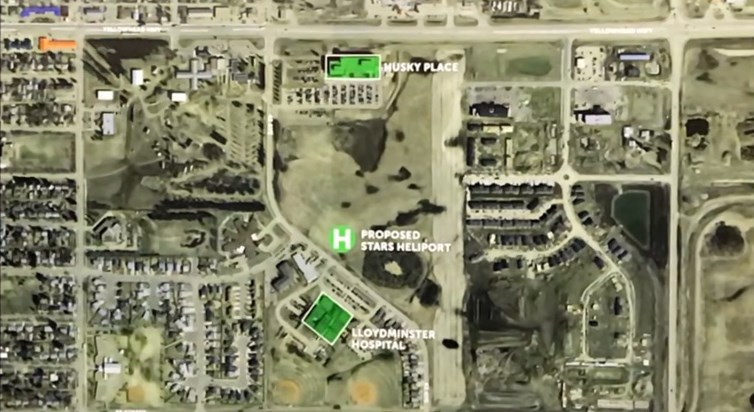Lloydminster – Patients requiring urgent transfers from Lloydminster Hospital will benefit from a more timely response, thanks to Husky Energy’s support for construction of a helicopter landing pad adjacent to the hospital. The site is across 43 Avenue from the hospital, on Husky land. It’s across a greenspace south of Husky Place.
Husky is contributing land, financial and other in-kind support. The Lloydminster Region Health Foundation (LRHF) is leading a fundraising campaign to pay for the remaining costs of about $200,000 for the nearly $350,000 project.
“The most significant impact of this project will be on the patients who are able to benefit from a more timely transfer with fewer handovers along the way,” said Scott Livingstone, chief executive officer of the Saskatchewan Health Authority on April 20. “Thank you to Husky for its leadership in not only donating to the project, but in having the foresight and determination to plan, coordinate, and execute from beginning to end. We appreciate the work of the Lloydminster Region Health Foundation and community partners who are also pivotal in making this possible.”
Livingstone said the helipad will reduce the number of patient handovers between referring and receiving health care teams. While best efforts are made by the professionals involved in handing care of the patient to another team, the process carries inherent risks for the patient in the areas of communication between care teams and continuity of care for a critical patient. STARS transport via the helipad would reduce these risks to the patient and improve patient stability.
“In an emergency, time can be the difference between life and death. This helipad will provide a critical service to the people of Lloydminster and the surrounding area, allowing health care professionals to treat patients more quickly,” said Paul Zorgdrager, vice president of heavy oil operations. “We live and work in this community. We want to support initiatives like this that will help so many of our neighbours.”
An additional benefit from the project is that EMS ground ambulance crews will no longer need to transport aircrews to and from the Lloydminster airport which is located 10 kilometers from the hospital. There will also be reduced time associated with ground transport to/from the hospital that will free up STARS crews for other priorities.
‚ÄúThis project ultimately means lives saved for families in our community for many years to come. Each participant, from the planners to the site workers, will talk to their children and grandchildren about –°¿∂ ”∆µ a part of it,‚Äù said Malcolm Radke, Chief Executive Officer, LRHF. ‚ÄúThank you to Husky for their leadership in donating to the project, and to our local partners, Musgrave Agencies, all of their construction partners, the Lloydminster Rotary Club, and City of Lloydminster for answering the call once again for their families and neighbours. We are excited to work alongside STARS and other frontline medical and emergency workers in the continued effort to enhance healthcare and save lives in our community.‚Äù
“Many lives have been saved because of our ability to provide transport and medical expertise to critically ill and injured patients via helicopter air ambulance,” said Andrea Robertson, president and CEO of STARS. “By landing our aircraft beside the Lloydminster Hospital, STARS will be able to get to patients living, working and travelling in the Lloydminster area more directly.”
The Lloydminster Hospital is a 66-bed acute care hospital serving a referral population of approximately 72,000 people. The facility currently does not have a heliport; all patient transfers occur by ground EMS directly or by ground EMS to and from Lloydminster Airport, connecting to fixed wing air ambulance or STARS service.
This capital campaign will bring a helipad to the Lloydminster Hospital on the adjacent Husky-owned land. This addition ultimately means that when air ambulance transfer is needed for quick response to traumatic incidents or to worsening chronic conditions, patients could be transported to expert medical specialists in urban hospitals within an hour, significantly reducing transfer times.




